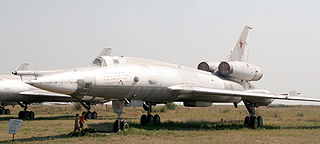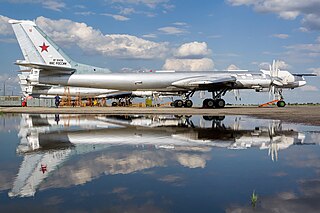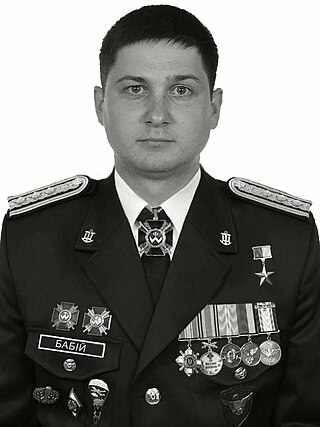
The Tupolev Tu-22 was the first supersonic bomber to enter production in the Soviet Union. Manufactured by Tupolev, the Tu-22 entered service with Long-Range Aviation and Soviet Naval Aviation in the 1960s.

The Tupolev Tu-160 is a supersonic, variable-sweep wing nuclear-capable heavy strategic bomber and airborne missile platform designed by the Tupolev Design Bureau in the Soviet Union in the 1970s. It is the largest and heaviest Mach 2+ supersonic military aircraft ever built and second to the experimental XB-70 Valkyrie in overall length and top speed. As of 2024, it is the largest and heaviest combat aircraft, the fastest bomber in use and the largest and heaviest variable-sweep wing airplane ever flown. The Tu-160 is operated by the Long Range Aviation of the Russian Aerospace Forces.

The Tupolev Tu-95 is a large, four-engine turboprop-powered strategic bomber and missile platform. First flown in 1952, the Tu-95 entered service with the Long-Range Aviation of the Soviet Air Forces in 1956 and was first used in combat in 2015. It is expected to serve the Russian Aerospace Forces until at least 2040.

The Tupolev Tu-22M is a supersonic, variable-sweep wing, long-range strategic and maritime strike bomber developed by the Tupolev Design Bureau in the 1960s. The bomber was reported as being designated Tu-26 by Western intelligence at one time. During the Cold War, the Tu-22M was operated by the Soviet Air Forces (VVS) in a missile carrier strategic bombing role, and by the Soviet Naval Aviation in a long-range maritime anti-shipping role. As of 2021, there were 66 of the aircraft in service.
The Kh-22 "Storm" is a large, long-range anti-ship missile developed by MKB Raduga in the Soviet Union. It was designed for use against aircraft carriers and carrier battle groups, with either a conventional or nuclear warhead. Kh-32 is an updated conventional variant of the Kh-22 and was accepted to service in 2016; it features an improved rocket motor and a new seeker head.

The NPO Almaz S-200 Angara/Vega/Dubna, NATO reporting name SA-5 Gammon, is a long-range, high-altitude surface-to-air missile (SAM) system developed by the Soviet Union in the 1960s to defend large areas from high-altitude bombers or other targets. In Soviet service, these systems were deployed primarily on the battalion level, with six launchers and a fire control radar.

The Tupolev Tu-141 Strizh is a Soviet reconnaissance drone that served with the Soviet Army during the late 1970s and 1980s, as well as the Ukrainian Armed Forces since 2014.

Olenya has been a major Russian Navy reconnaissance base, located on the Kola Peninsula 92 km south of Murmansk. As of 2020, units at the base are subordinate to the Long-Range Aviation branch of the Russian Aerospace Forces. The base and its staff settlement, across Lake Permusozero from the city of Olenegorsk, are served by the Olenegorsk rail station. Olenya has served as the headquarters for 5 MRAD, and has hosted two reconnaissance regiments. Its 3500-meter runway is the longest on the Kola Peninsula, making it a key facility for intercontinental flights across the North Atlantic basin.

Soltsy-2 is an air base in Novgorod Oblast, Russia located 2 km north of Soltsy and 72 km southwest of Novgorod. It contains large aircraft revetments, with a separate compound of 9 hardened areas about 1 mile from the airfield.

Long-Range Aviation is a sub-branch of the Russian Aerospace Forces responsible for delivering long-range nuclear or conventional strikes by aircraft. The Russian Long Range Aviation and its now-dissolved Ukrainian counterpart were both previously part of the Soviet Air Forces, before it was split into the Air Forces of its many successor states, most notably the Russian Air Force and Ukrainian Air Force. Those branches were tasked with long-range bombardment of strategic targets with nuclear weapons.

Shaykovka, also given variously as Kirov Shaykovka, Anisovo Gorod, Anisovo Gorodishche, Shaykovo, Shajkovka, Gorodische, Chaikovka, is an airbase of the Russian Aerospace Forces in Kaluga Oblast, Russia located 17 km north of Kirov, Kaluga Oblast. It is a large airfield with hangars and an extensive alert area for fighters. Appears the runway overrun was being built to extend the runway to 3000 m. In 2000, Tupolev Tu-160, Tupolev Tu-95MS, and Tupolev Tu-22M3 aircraft operated out of this base during a training exercise. The Natural Resources Defense Council listed the base as a nuclear site in a study.

Dyagilevo is an air base in Ryazan Oblast, Russia, 3 km west of Ryazan. It serves as a training center for Russia's strategic bomber force.

Engels-2 is a strategic bomber military airbase in Russia located 14 kilometres (8.7 mi) east of Saratov. Engels is a major bomber operations base, and is Russia's sole operating location for the Tupolev Tu-160 strategic bomber. The base has a 3,500-metre (11,500 ft) runway and about 10 large revetments. It is named after the nearby city of Engels, which is named after the Communist philosopher, Friedrich Engels.

Poltava Air Base is a military airfield located approximately 8 km (5.0 mi) northwest of Poltava, Ukraine. It is one of two airfields near Poltava, the other being Poltava Airport.

The 22nd Guards Donbas Red Banner Heavy Bomber Aviation Division is a division of the Russian Aerospace Force's Long-Range Aviation branch having previously been a Soviet Air Forces formation. It was a Long Range Aviation division active from 1942 to 2008–9. Included in the 37th Air Army High Command. Commander of the division was Major General Alexander Blazhenko. It saw illustrious service during the Second World War, including supply of the Red Army in the Demyansk Pocket and the bombing of Berlin.

Vozdvizhenka is an air base in Primorsky Krai located close to the village of Vozdvizhenka. This base was dedicated to Pacific heavy long-range bomber fleet, housing the 444th Berlin Order of Kutuzov 3rd degree and Alexander Nevsky Heavy Bomber Aviation Regiment, part of the 326th Heavy Bomber Aviation Division, 37th Air Army.

Kh-32 is a Russian supersonic air-launched cruise missile with a range of 600–1000 km developed by the MKB Raduga from the Kh-22. The missile was accepted to service in 2016 as armament for the Tu-22M3M bombers.

The Long Range Aviation Group ; abbr. AGDA / АГДА), was a military organisation, subordinate to the Central High Command of the Ukrainian Air Force, which included the long-range aircraft of Ukraine. Ukrainian Long Range Aviation was disbanded in 2007.

Oleh Ivanovych Babiy was a Ukrainian military officer, colonel of the Main Directorate of Intelligence of Ukraine, and a participant of the Russo-Ukrainian War. He was posthumously conferred the title of Hero of Ukraine with the Order of the Gold Star.


















